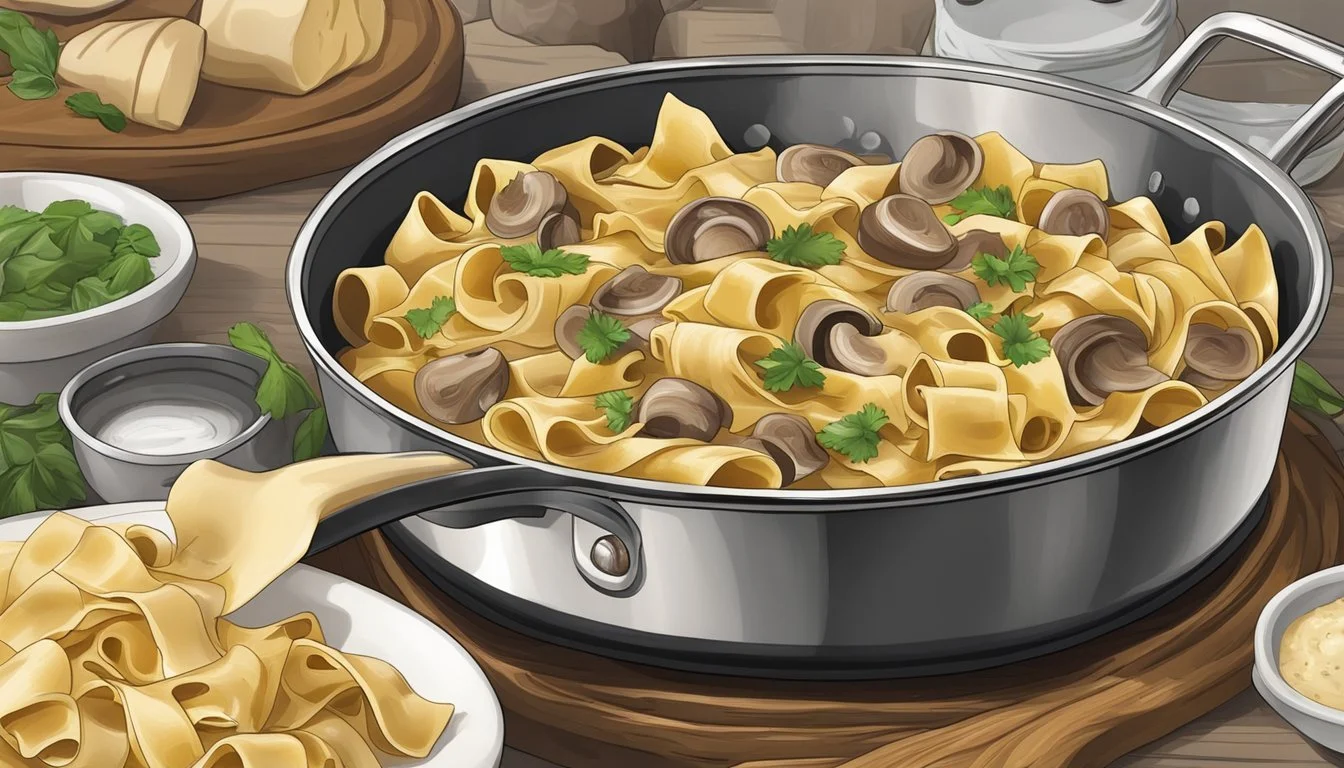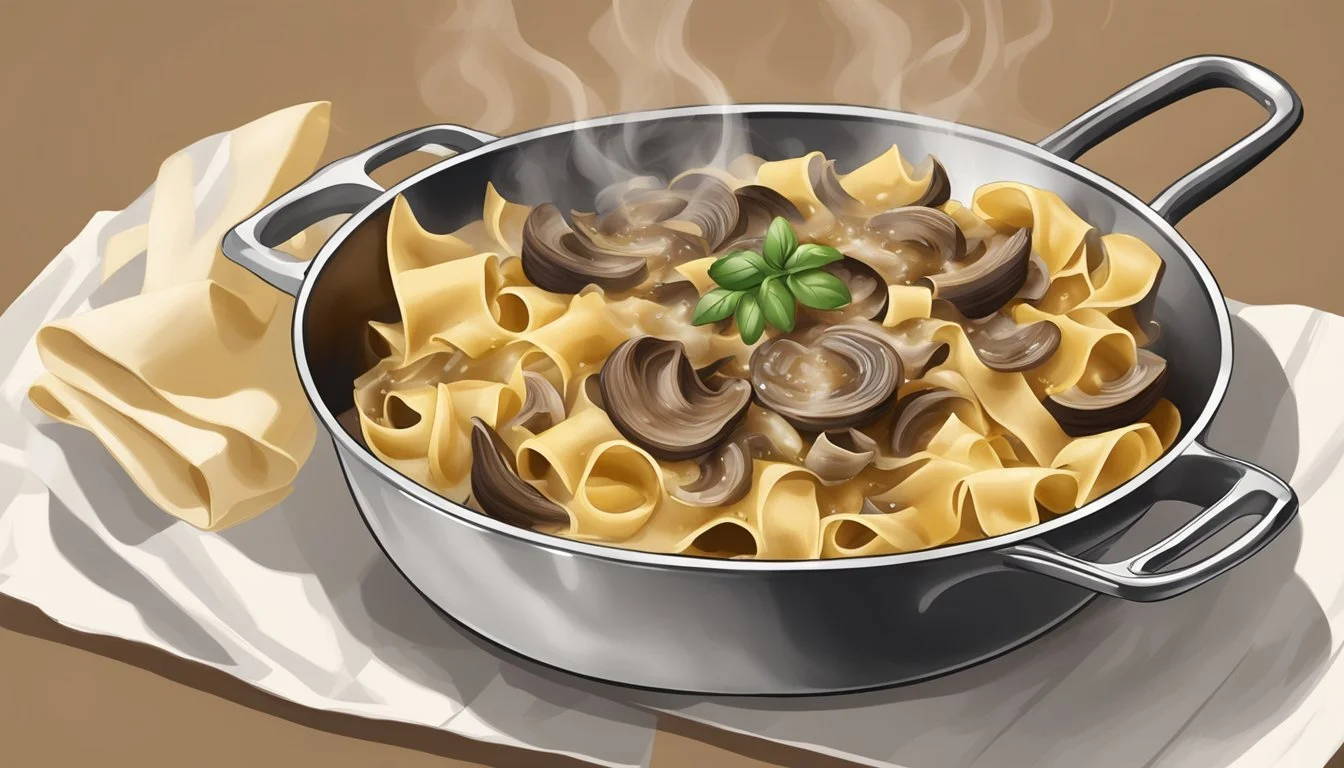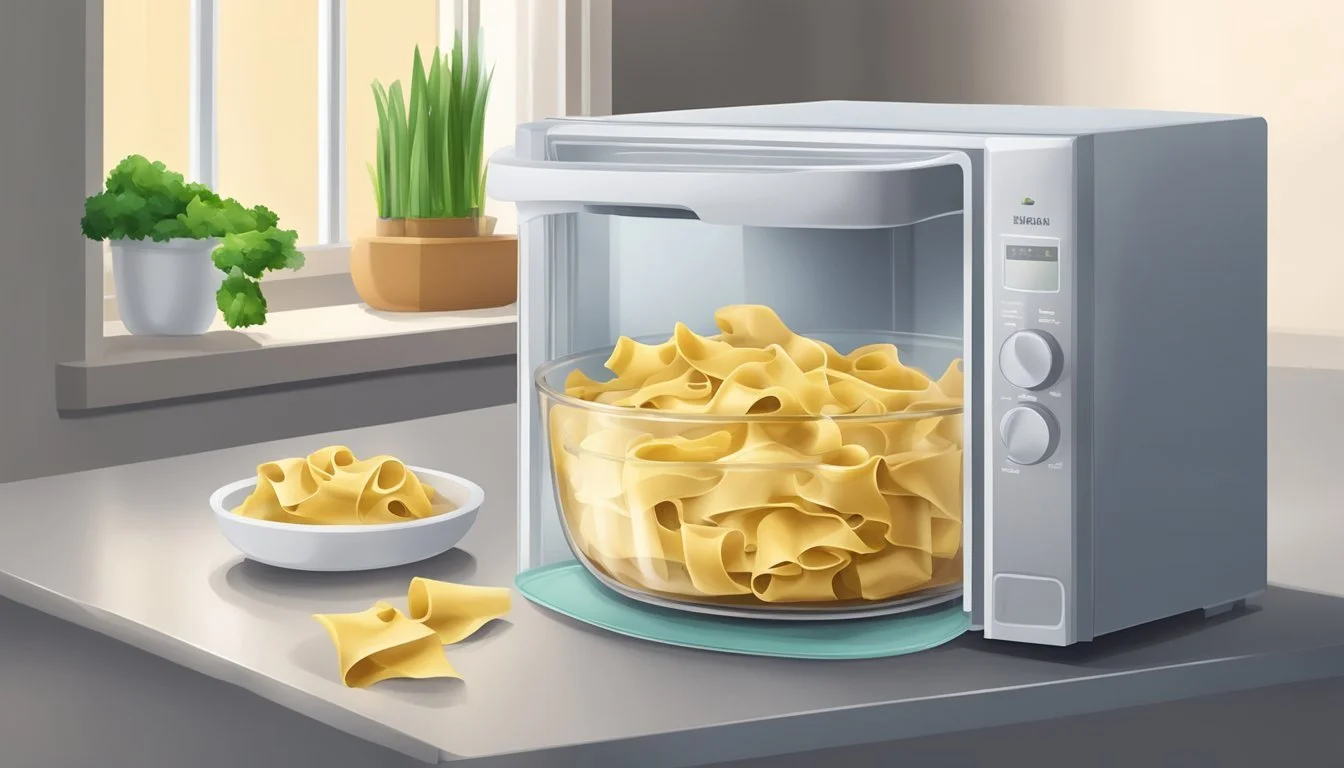Best Way to Reheat Pappardelle with Mushroom Sauce
Ensuring Al Dente Pasta and Rich Flavor
Reheating pappardelle with mushroom sauce poses a unique challenge for pasta (What wine goes well with pasta?) lovers who want to enjoy their meal as much as they did the first time. Pappardelle, with its broad, flat shape, is particularly prone to sticking together and losing its delectable al dente texture. Meanwhile, the creamy mushroom sauce requires careful attention to prevent separation and to maintain a rich, smooth consistency.
To address these challenges, it's important to use techniques that gently warm both pasta and sauce to the right temperature without compromising their individual qualities. Understanding the properties of these complex components is key; the pasta needs to maintain its texture without becoming too soft, while the sauce must be heated in a way that preserves its emulsified state, ensuring each strand of pappardelle is evenly coated.
Selecting the right reheating method can make all the difference in reviving leftover pappardelle with mushroom sauce. Options vary from using the stovetop to employing the oven's gentle heat, and even leveraging the convenience of a microwave with careful timing. The aim is to achieve a dish that feels as freshly made as possible, pleasing the palate with the same al dente pasta and richly flavored sauce savored in the initial serving.
Understanding Pappardelle Pasta
Pappardelle pasta, with its broad ribbons, calls for exact cooking techniques to maintain an al dente texture while pairing beautifully with rich sauces.
Pasta Varieties: Spotlight on Pappardelle
Pappardelle is a type of pasta that features wide, flat ribbons, setting it apart from narrower varieties like spaghetti. These broad noodles originate from Italy and are particularly suited for hearty, chunky sauces which cling to the expansive surface area. Pappardelle typically measures between 2/3-inch to 1-inch in width, offering a substantial bite that is capable of withstanding robust flavors.
When cooking pappardelle, the goal is to achieve an al dente texture, meaning the pasta should be firm to the bite yet cooked through. Achieving this balance is crucial in pasta recipes featuring pappardelle, as it ensures that the pasta maintains its structure when mixed with a sauce.
The Science of Cooking Pasta to Al Dente
Cooking pasta to al dente is a precise science that hinges on timing and temperature. For pappardelle, one must bring a large pot of boiling water to a rolling boil to allow ample space for the noodles to cook evenly. The addition of salt to the water not only seasons the pasta but also raises the boiling point, affecting the cook time.
Once the pappardelle is submerged into the boiling water, it's critical to stir occasionally to prevent sticking and promote even cooking. A general guide for cook time is provided on pasta packages; however, taste testing towards the end of the suggested period is key to ensure an al dente result. The cook time for pappardelle generally ranges from 7 to 10 minutes. Immediately upon reaching al dente, the pasta should be drained from the boiling water.
Crafting the Perfect Mushroom Sauce
Creating an impeccable mushroom sauce starts with the choice of mushrooms (What wine goes well with mushrooms?) and hinges on the balance of flavors and textures. It's about enriching the natural umami of mushrooms with complementary ingredients for a harmonious blend.
Selecting Your Mushrooms
The foundation of any mushroom sauce is, unsurprisingly, the mushrooms themselves. A variety of mushrooms brings complexity and depth to the sauce. Here are some excellent choices:
Cremini mushrooms: Richer flavor compared to white button mushrooms.
Oyster mushrooms: Delicate texture and slightly woody flavor.
Maitake: Known for their earthy taste and ability to retain texture.
Selecting a mix of wild and cultivated mushrooms, like oyster and cremini, adds layers of flavor and robustness. Ensure mushrooms are firm, clean, and fresh to contribute the best taste and nutrition.
Elements of a Rich Mushroom Sauce
The secret to a rich and creamy mushroom sauce lies in its components and their precise preparation.
Fat: Begin with quality olive oil and unsalted butter to sauté the mushrooms; this base introduces richness and helps to release the flavors of the aromatic ingredients.
Aromatics: Finely chopped garlic is essential. Sauté until fragrant, being careful not to burn it. Fresh herbs such as rosemary and thyme complement the mushrooms' earthy notes.
Liquid: A splash of white wine deglazes the pan and adds acidity, which balances the sauce's richness. Following this, heavy cream is stirred in, creating a velvety texture.
Thickeners: A sprinkle of flour can be used to thicken the sauce, though careful moderation is key to prevent a pasty consistency.
Seasoning: Salt and black pepper are the basic seasonings that enhance the natural flavors. Fresh lemon juice may be added to cut through the cream’s richness and to elevate the final taste.
Protein: If desired, the sauce can be enriched further with a protein such as cooked chicken or shrimp.
This methodical combination of mushrooms, fats, liquids, and seasonings produces a mushroom sauce that is not only rich and creamy but also retains the integrity of its primary ingredients—the mushrooms.
Storing Leftover Pasta and Sauce
When preserving the quality of pappardelle with mushroom sauce, appropriate storage is crucial for maintaining the pasta's al dente texture and the richness of the sauce.
Best Practices for Refrigerating Pappardelle and Mushroom Sauce
To optimize the shelf life of cooked pappardelle with mushroom sauce while maintaining taste and safety, one should refrigerate the pasta in shallow airtight containers or resealable plastic bags. It is recommended to cool the pappardelle and sauce at room temperature before refrigerating to lessen the risk of condensation, which can degrade the pasta's texture and dilute the sauce's flavor. Proper cooling should not exceed 30 minutes to prevent bacterial growth. Utilizing the refrigerator promptly keeps the pappardelle al dente and the mushroom sauce rich and prevents spoilage. The inclusion of cream in the sauce may affect its consistency upon reheating, so gentle heating is advisable. Adding a small amount of oil or cream when reheating can help maintain the sauce's creamy consistency. Refrigeration can effectively extend the dish's enjoyment for up to 3-5 days.
Key Tips to Prevent Pasta from Sticking
To preserve the integrity of leftover pappardelle:
Cool Separately: If possible, store the pasta and mushroom sauce in separate airtight containers. Pasta can stick when stored in sauce due to the starches continuing to absorb moisture.
Add a Dash of Oil: Toss the pappardelle lightly with olive oil or a small pat of butter, which can act as a barrier to prevent sticking without affecting the overall polyunsaturated fat content significantly.
Portion Control: Store servings individually to make reheating more convenient and to avoid re-refrigerating what you don't consume, which can compromise the quality.
By adhering to these methods, the pappardelle retains its al dente quality, and mushroom sauce keeps its consistency rich, while the calorie, fat, sodium, and carbohydrate content are maintained for an enjoyable meal upon reheating.
Mastering the Reheating Process
Reheating pappardelle with mushroom sauce requires attention to detail to maintain the pasta's al dente texture and the sauce's richness. Here are specific techniques to ensure your leftover pasta returns to a state that rivals its initial serving.
Preparation Before Reheating
Before applying heat, one should add a small amount of olive oil or pasta water to the pappardelle. This helps to revive the texture and prevent sticking. Distributing the mushroom sauce evenly ensures consistent warming throughout the pasta.
Reheating on the Stove
Instructions for the Stove:
Place a skillet on the stove over low heat.
Add the pasta leftovers along with a splash of pasta water or cream.
Stir gently, allowing the sauce to emulsify and evenly coat the pasta.
Prep Time: 2 minutes
Total Time: Approximately 10 minutes
Using the Oven for Reheating
Equipment Needed:
Oven-safe dish
Aluminum foil
Instructions:
Preheat the oven to 350°F (177°C).
Transfer the pappardelle and sauce to the dish and cover with foil to create steam, which helps in preventing drying out.
Heat for 10-15 minutes or until hot.
Prep Time: 5 minutes
Total Time: 20 minutes
Microwave Reheating: Does it Work?
While the microwave is a quick method, it's not the preferred option for pappardelle with mushroom sauce, as it can unevenly heat and overcook the pasta. If it's the only option:
Place the pasta in a microwave-safe dish.
Drizzle with a bit of liquid (cream, pasta water, or olive oil) and cover with a damp paper towel to create steam.
Set the microwave to 50% power and heat in short intervals, stirring in between.
Prep Time: 1 minute
Total Time: 3-5 minutes
Finishing Touches and Enhancements
After reheating, a well-prepared dish of Pappardelle with Mushroom Sauce needs the final touches that elevate its flavors and presentation. These details ensure the pasta remains al dente and the rich sauce clings to each ribbon.
Adjusting Seasonings and Consistency
The sauce's flavor may need recalibration after reheating. Begin by tasting and consider adding a pinch of salt and black pepper to enhance the natural flavors of the mushrooms. A dash of milk or heavy cream can restore the sauce's creamy texture if it's reduced too much, while a spoonful of butter reintegrated over low heat can add a silky richness. Stirring in a small amount of olive oil may also help in loosening the sauce to coat the pasta evenly.
Salt: Rebalance as necessary.
Black Pepper: Freshly ground to invigorate.
Milk/Heavy Cream: Add sparingly to adjust consistency.
Butter: Melt into the sauce for a velvety finish.
Olive Oil: A drizzle can help bind the sauce to the pasta.
Garnishing for a Gourmet Touch
A garnish should complement both the aesthetic and palate. Finely chopped fresh parsley provides a burst of color and a hint of freshness, which contrasts the savory sauce. A generous grating of Parmesan cheese affords a nutty undertone and completes the dish with an umami punch. For an aromatic lift, incorporate a delicate sprinkle of fresh herbs such as rosemary or other garden favorites you may have on hand. If desiring a bright accent, a zest of lemon can provide a light citrus note that cuts through the fat, enhancing the overall experience.
Fresh Parsley: Chopped, for color and freshness.
Parmesan Cheese: Freshly grated for depth.
Herbs (Rosemary, etc.): A light touch for fragrance.
Lemon Zest: Adds a refreshing twist.
By adjusting the seasonings and adding thoughtful garnishes, the pappardelle with mushroom sauce will not only be reheated perfectly but also be endowed with a renewed gourmet appeal.




